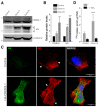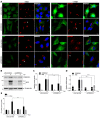Transcription Factor CREB3L1 Regulates the Expression of the Sodium/Iodide Symporter (NIS) in Rat Thyroid Follicular Cells
- PMID: 35455992
- PMCID: PMC9029047
- DOI: 10.3390/cells11081314
Transcription Factor CREB3L1 Regulates the Expression of the Sodium/Iodide Symporter (NIS) in Rat Thyroid Follicular Cells
Abstract
The transcription factor CREB3L1 is expressed in a wide variety of tissues including cartilage, pancreas, and bone. It is located in the endoplasmic reticulum and upon stimulation is transported to the Golgi where is proteolytically cleaved. Then, the N-terminal domain translocates to the nucleus to activate gene expression. In thyroid follicular cells, CREB3L1 is a downstream effector of thyrotropin (TSH), promoting the expression of proteins of the secretory pathway along with an expansion of the Golgi volume. Here, we analyzed the role of CREB3L1 as a TSH-dependent transcriptional regulator of the expression of the sodium/iodide symporter (NIS), a major thyroid protein that mediates iodide uptake. We show that overexpression and inhibition of CREB3L1 induce an increase and decrease in the NIS protein and mRNA levels, respectively. This, in turn, impacts on NIS-mediated iodide uptake. Furthermore, CREB3L1 knockdown hampers the increase the TSH-induced NIS expression levels. Finally, the ability of CREB3L1 to regulate the promoter activity of the NIS-coding gene (Slc5a5) was confirmed. Taken together, our findings highlight the role of CREB3L1 in maintaining the homeostasis of thyroid follicular cells, regulating the adaptation of the secretory pathway as well as the synthesis of thyroid-specific proteins in response to TSH stimulation.
Keywords: CREB3L1; cellular homeostasis; endoplasmic reticulum; iodide uptake; sodium/iodide symporter (NIS); thyroid follicular cells.
Conflict of interest statement
The authors declare no conflict of interest. The funders had no role in the design of the study; in the collection, analyses, or interpretation of data; in the writing of the manuscript, or in the decision to publish the results.
Figures






Similar articles
-
A Critical Balance Between PAX8 and the Hippo Mediator TAZ Determines Sodium/Iodide Symporter Expression and Function.Thyroid. 2022 Mar;32(3):315-325. doi: 10.1089/thy.2021.0191. Epub 2021 Dec 31. Thyroid. 2022. PMID: 34726504
-
Sterol regulatory element-binding proteins are regulators of the NIS gene in thyroid cells.Mol Endocrinol. 2013 May;27(5):781-800. doi: 10.1210/me.2012-1269. Epub 2013 Mar 29. Mol Endocrinol. 2013. PMID: 23542164 Free PMC article.
-
CREB3L1-mediated functional and structural adaptation of the secretory pathway in hormone-stimulated thyroid cells.J Cell Sci. 2017 Dec 15;130(24):4155-4167. doi: 10.1242/jcs.211102. Epub 2017 Nov 1. J Cell Sci. 2017. PMID: 29093023 Free PMC article.
-
Enhancement of sodium/iodide symporter expression in thyroid and breast cancer.Endocr Relat Cancer. 2006 Sep;13(3):797-826. doi: 10.1677/erc.1.01143. Endocr Relat Cancer. 2006. PMID: 16954431 Review.
-
Minireview: The sodium-iodide symporter NIS and pendrin in iodide homeostasis of the thyroid.Endocrinology. 2009 Mar;150(3):1084-90. doi: 10.1210/en.2008-1437. Epub 2009 Feb 5. Endocrinology. 2009. PMID: 19196800 Free PMC article. Review.
Cited by
-
The Regulatory Network of CREB3L1 and Its Roles in Physiological and Pathological Conditions.Int J Med Sci. 2024 Jan 1;21(1):123-136. doi: 10.7150/ijms.90189. eCollection 2024. Int J Med Sci. 2024. PMID: 38164349 Free PMC article. Review.
-
Targeted Next-Generation Sequencing of Congenital Hypothyroidism-Causative Genes Reveals Unexpected Thyroglobulin Gene Variants in Patients with Iodide Transport Defect.Int J Mol Sci. 2022 Aug 17;23(16):9251. doi: 10.3390/ijms23169251. Int J Mol Sci. 2022. PMID: 36012511 Free PMC article.
-
Lack of Nuclear Localization of the Creb3l1 Transcription Factor Causes Defects in Caudal Fin Bifurcation in Zebrafish Danio rerio.Cells Tissues Organs. 2025;214(2):77-95. doi: 10.1159/000540103. Epub 2024 Jul 17. Cells Tissues Organs. 2025. PMID: 38964305 Free PMC article.
-
Disruption of the creb3l1 gene causes defects in caudal fin regeneration and patterning in zebrafish Danio rerio.Dev Dyn. 2024 Dec;253(12):1106-1129. doi: 10.1002/dvdy.726. Epub 2024 Jul 14. Dev Dyn. 2024. PMID: 39003620 Free PMC article.
-
STAT6 blockade ameliorates thyroid function in Graves' disease via downregulation of the sodium/iodide symporter.Endocr Connect. 2024 Nov 22;13(12):e240428. doi: 10.1530/EC-24-0428. Print 2024 Dec 1. Endocr Connect. 2024. PMID: 39393405 Free PMC article.
References
-
- Honma Y., Kanazawa K., Mori T., Tanno Y., Tojo M., Kiyosawa H., Takeda J., Nikaido T., Tsukamoto T., Yokoya S., et al. Identification of a novel gene, OASIS, which encodes for a putative CREB/ATF family transcription factor in the long-term cultured astrocytes and gliotic tissue. Brain Res. Mol. Brain Res. 1999;69:93–103. doi: 10.1016/S0169-328X(99)00102-3. - DOI - PubMed
Publication types
MeSH terms
Substances
LinkOut - more resources
Full Text Sources
Molecular Biology Databases

